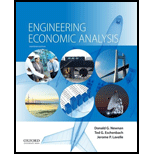
The three alternatives for MACRS 3-year property.
Answer to Problem 72P
Choose Alternative C..
Explanation of Solution
Given:
The after-tax MARR is
The project life is
The combined incremental tax rate is
Calculation:
Alternate A:
Write the formula to calculate the
Here, depreciation charge in any year
Write the formula to calculate the
Determine the values of
A table would be most suitable to calculate the values of
| Recovery year, |
MACRS percentage rate for the recovery year |
Calculate the depreciation charge for
Substitute
Calculate the
Substitute
Calculate the depreciation charge for
Substitute
Calculate the
Calculate the depreciation charge for
Substitute
Calculate the
Write the values of annual depreciation charge and Net book value in tabular form.
| Year, |
Base book value (a) | Depreciation charge for year |
Net book value(a-b) |
| 1 | |||
| 2 | |||
| 3 |
Write the formula to calculate the taxable incomes.
Calculate the taxable incomes for
Substitute
Calculate the
Write the formula to calculate the after-tax cash flow.
Calculate the after-tax cash flow.
Substitute
Calculate the After-tax cash flow for the remaining years in tabular form.
| Period | Before-tax cash flow(p) | MACRS Depreciation(q) | Taxable Incomes |
Income taxes ( |
After-tax cash flow |
Write the equation for present worth factor of annuity
Here, initial payment is
Calculate present worth factor of annuity.
Substitute
Thus, the present worth value for Alternate A is
Alternate B:
Determine the values of
A table would be most suitable to calculate the values of
| Recovery year, |
MACRS percentage rate for the recovery year |
Calculate the depreciation charge for
Substitute
Calculate the
Substitute
Calculate the depreciation charge for
Substitute
Calculate the
Calculate the depreciation charge for
Substitute
Calculate the
Write the values of annual depreciation charge and Net book value in tabular form.
| Year, |
Base book value(a) | Depreciation charge for year |
Net book value(a-b) |
| 1 | |||
| 2 | |||
| 3 |
Calculate the taxable incomes for
Substitute
Calculate the
Calculate the After-tax cash flow.
Substitute
Calculate the After-tax cash flow for the remaining years in tabular form.
| Period | Before-tax cash flow(p) | MACRS Depreciation(q) | Taxable Incomes |
Income taxes ( |
After-tax cash flow |
Calculate present worth factor of annuity.
Substitute
Thus, the present worth value for Alternate B is
Alternate C:
Determine the values of
A table would be most suitable to calculate the values of
| Recovery year, |
MACRS percentage rate for the recovery year |
Calculate the depreciation charge for
Substitute
Calculate the
Substitute
Calculate the depreciation charge for
Substitute
Calculate the
Calculate the depreciation charge for
Substitute
Calculate the
Write the values of annual depreciation charge and Net book value in tabular form.
| Year, |
Base book value(a) | Depreciation charge for year |
Net book value(a-b) |
| 1 | |||
| 2 | |||
| 3 |
Calculate the taxable incomes for
Substitute
Calculate the
Calculate the After-tax cash flow.
Substitute
Calculate the After-tax cash flow for the remaining years in tabular form.
| Period | Before-tax cash flow(p) | MACRS Depreciation(q) | Taxable Incomes(p-q) | Income taxes ( |
After-tax cash flow |
Calculate present worth factor of annuity.
Substitute
Thus, the present worth value for Alternate C is
Conclusion:
Alternative C will have much greater positive value of
Thus, choose Alternative C.
Want to see more full solutions like this?
Chapter 12 Solutions
Engineering Economic Analysis
- Answerarrow_forwardM” method Given the following model, solve by the method of “M”. (see image)arrow_forwardAs indicated in the attached image, U.S. earnings for high- and low-skill workers as measured by educational attainment began diverging in the 1980s. The remaining questions in this problem set use the model for the labor market developed in class to walk through potential explanations for this trend. 1. Assume that there are just two types of workers, low- and high-skill. As a result, there are two labor markets: supply and demand for low-skill workers and supply and demand for high-skill workers. Using two carefully drawn labor-market figures, show that an increase in the demand for high skill workers can explain an increase in the relative wage of high-skill workers. 2. Using the same assumptions as in the previous question, use two carefully drawn labor-market figures to show that an increase in the supply of low-skill workers can explain an increase in the relative wage of high-skill workers.arrow_forward
- Published in 1980, the book Free to Choose discusses how economists Milton Friedman and Rose Friedman proposed a one-sided view of the benefits of a voucher system. However, there are other economists who disagree about the potential effects of a voucher system.arrow_forwardThe following diagram illustrates the demand and marginal revenue curves facing a monopoly in an industry with no economies or diseconomies of scale. In the short and long run, MC = ATC. a. Calculate the values of profit, consumer surplus, and deadweight loss, and illustrate these on the graph. b. Repeat the calculations in part a, but now assume the monopoly is able to practice perfect price discrimination.arrow_forwardThe projects under the 'Build, Build, Build' program: how these projects improve connectivity and ease of doing business in the Philippines?arrow_forward

 Principles of Economics (12th Edition)EconomicsISBN:9780134078779Author:Karl E. Case, Ray C. Fair, Sharon E. OsterPublisher:PEARSON
Principles of Economics (12th Edition)EconomicsISBN:9780134078779Author:Karl E. Case, Ray C. Fair, Sharon E. OsterPublisher:PEARSON Engineering Economy (17th Edition)EconomicsISBN:9780134870069Author:William G. Sullivan, Elin M. Wicks, C. Patrick KoellingPublisher:PEARSON
Engineering Economy (17th Edition)EconomicsISBN:9780134870069Author:William G. Sullivan, Elin M. Wicks, C. Patrick KoellingPublisher:PEARSON Principles of Economics (MindTap Course List)EconomicsISBN:9781305585126Author:N. Gregory MankiwPublisher:Cengage Learning
Principles of Economics (MindTap Course List)EconomicsISBN:9781305585126Author:N. Gregory MankiwPublisher:Cengage Learning Managerial Economics: A Problem Solving ApproachEconomicsISBN:9781337106665Author:Luke M. Froeb, Brian T. McCann, Michael R. Ward, Mike ShorPublisher:Cengage Learning
Managerial Economics: A Problem Solving ApproachEconomicsISBN:9781337106665Author:Luke M. Froeb, Brian T. McCann, Michael R. Ward, Mike ShorPublisher:Cengage Learning Managerial Economics & Business Strategy (Mcgraw-...EconomicsISBN:9781259290619Author:Michael Baye, Jeff PrincePublisher:McGraw-Hill Education
Managerial Economics & Business Strategy (Mcgraw-...EconomicsISBN:9781259290619Author:Michael Baye, Jeff PrincePublisher:McGraw-Hill Education





